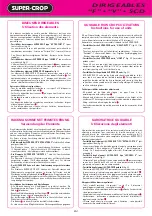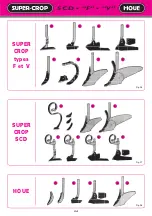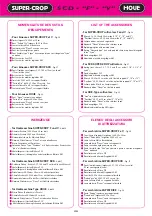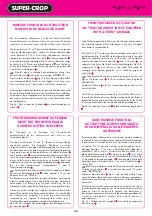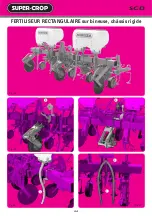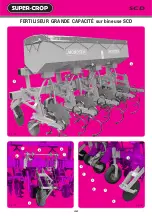
SCD • “F” • “V”
33
CHASSIS A REPLIAGE HYDRAULIQUE
La barre porte-outils, en 3 parties, permet le repliage de 2 - 3 ou 4 éléments de
chaque extrémité. Les bineuses autoguidées et les bineuses à direction peuvent être
repliables. Avec les équipements "F" et "V", seules les variantes sans balanciers sont
repliables (C1L – DF5 – V1L). Suivant le nombre de rangs et la distance entre rangs,
3 châssis sont disponibles :
1) Barre centrale de 2,30 m et latérales 1,45 m pour bineuse 6 rangs de
70 à 80 cm - 7 rangs de 55 à 65 cm - 8 rangs de 45 à 50 cm - 9 rangs à 55 cm -
10 rangs de 45 à 50 cm.
2) Barre centrale de 2,30 m et latérales 2,00 m pour bineuse 12 rangs à 45 ou 50 cm.
3) Barre centrale de 2,30 m et latérales 2,20 m pour bineuse 8 rangs à 75 ou 80 cm.
Une bineuse à 8 rangs à 75 ou 80 cm peut se transformer en 12 rangs à 45 ou
50 cm, mais pas l’inverse.
MONTAGE :
• Suivant Fig. 47 et 48 pour 6 rangs maïs, 7 rangs tournesol…
☞
Ce modèle s’équipe de 2 coutres de guidage 1 escamotables à monter sur
les parties repliables (penser à escamoter les disques avant repliage).
• Suivant Fig. 53 pour les modèles 8 rangs maïs - 12 rangs betterave. Les 2 coutres
de guidage 2 standards se montent sur la partie centrale. Les éléments à tête
spécifique Fig. 54 sont à placer de chaque côté de l’élément central, sauf à 75 ou
80 cm. Les vérins de repliage sont à brocher suivant Fig. 55 : dans le trou "A" pour
un inter-rangs de 45 cm. Dans le trou "B" pour les inter-rangs de 50 - 75 et 80 cm.
Les crochets de verrouillage 6 possèdent deux positions :
- suivant Fig. 56 pour inter-rangs de 45 cm
- suivant Fig. 57 pour inter-rangs de 50 - 75 et 80 cm. De plus, les trous oblongs
permettent d’affiner le réglage.
IMPORTANT : Au moment du repliage, pour un inter-rangs de 80cm, il est
indispensable de placer la cale 5 Fig. 52 sur les éléments latéraux. Au repos, 2
cales 5 sont à mettre sur les éléments centraux.
OPÉRATION de PLIAGE et DÉPLIAGE : ces manœuvres sont à exécuter bineuse
ATTELÉE et RELEVÉE. Les broches 3 retirées et les coutres 1 escamotés, effectuer
lentement le 1
er
repliage ; surveiller en fin de course le moment où les têtes d’éléments
et les disques crantés s’entrecroisent avec les éléments de la partie centrale. Par
prudence, se tenir à l’écart de la machine lors du repliage.
Fig. 50 : montage avec attelage centré
Fig. 51 : montage avec attelage déporté ; parfois utilisé dans le cas d’un tracteur
avec une voie de 1,50 m pour biner à 50 cm.
!
Lors des déplacements, veiller à ne pas accrocher les lignes électriques ou les
fils téléphoniques.
(*)
Bineuse repliée pour les besoins de la photo (voir page 2).
HYDRAULIC FOLDING FRAME
The 3-piece toolbar allows folding of 2, 3 or 4 units on each end. Only self guided
and guideable cultivators can be folded. With the "F" and "V" accessories, only
versions without the swing arm can be folded (C1L, DF5, V1L). According to the
number of rows and the distance between rows, 3 frames are available :
1) Central bar of 2m30 and lateral bars of 1,45 m for 6-row cultivator from 70 to 80 cm
- 7 rows from 55 to 65 cm - 8 rows from 45 to50- cm - 9 rows at 55 cm - 10 rows
from 45 to 50 cm.
2) Central bar of 2,30 m and lateral bars of 2,00 m for 12-row cultivator at 45 or 50 cm.
3) Central bar of 2,30 m and lateral bars of 2,20 m for 8-row cultivator at 75 or 80 cm.
An 8-row cultivator at 75 or 80 cm can be transformed into 12 rows at 45 or 50 cm,
but not the contrary.
ASSEMBLY :
• According to fig. 47 and 48 for 6 rows maize, 7 rows sunflower ….
☞
This model can be equipped with retractable guiding coulters 1 to be assembled
on the folding parts (remember to retract the discs before folding).
• According to fig. 53 for the 8-row maize models - 12 rows sugarbeet. The 2
standard guiding coulters 2 are assembled on the central part. The units with
specific heads fig. 54 are to be place on each side of the central unit, except at 75
or 80 cm. The folding cylinders are to be positioned with the pins according to fig. 55 :
in the hole "A" for an inter row spacing of 45 cm. In the hole "B" for inter row spacings
of 50 - 75 and 80 cm. The locking hooks 6 have two positions :
- according to fig. 56 for inter rows of 45 cm
- according to fig. 57 for inter rows of 50 - 75 and 80 cm. Furthermore, the oblong
holes improves the adjustment.
IMPORTANT : When folding, for an inter row spacing of 80 cm, it is essential for
place the wedge 5 fig. 52 on the lateral units. When stationary, 2 wedges 5 are to
be positioned on the central units.
FOLDING and UNFOLDING : This should be done with the CULTIVATOR ATTACHED
TO THE TRACTOR AND IN A RAISED POSITION. With the pins 3 removed and the
coulters 1 retracted, proceed slowly with the folding. At the end of the folding
operation, watch for the head of the units of the rotating shields to criss-cross with
the units of the central part. For extra precaution, keep away from the machine
during the folding operation.
Fig. 50 : assembly with centred hitch
Fig. 51 : assembly with offset hitch ; sometimes used when a tractor has a track of
1,50 m for cultivating at 50cm.
!
During transport, extra precaution should be taken with electric and telephone
cables.
(*)
Cultivator folded for the requirements of the photo (see page 4).
RAHMEN HYDRAULISCH KLAPPBAR
D
er dreiteilige Werkzeugrahmen kann mit zwei oder drei Außenelementen hydraulisch
eingeklappt werden. Die selbstgesteuerten Hackmaschinen und die Hackmaschinen mit
Feinsteuerung lassen sich hydraulisch klappen. Die Hackmaschinen "F" und "V" können
nur eingeklappt werden, wenn sie ohne Pflanzenschutzscheiben (C1L – DF5 – V1L)
ausgerüstet sind. Je nach der Reihenanzahl und dem Reihenabstand sind 3 Rahmen
möglich :
1) Grundrahmen, 2,30 lang für 6-reihige Hackmaschine von 70 bis 80 cm - 7-reihige von 55
bis 65 cm - 8-reihige von 45 bis 50 cm - 9-reihige 55 cm - 10-reihige von 45 bis 50 cm.
2) Grundrahmen, 2,30 m lang und Seitenrahmen 2 m00 für 12-reihige Hackmaschine 45
oder 50 cm.
3) Grundrahmen, 2,30 m lang und Seitenrahmen 2,20 m für 8-reihige Hackmaschine 75
oder 80 cm. Eine 8-reihige Hackmaschine, 75 oder 80 cm kann in eine 12-reihige
Maschine 45 oder 50 cm umgebaut werden aber nicht das Gegenteil.
MONTAGE :
• Nach Abb. 47 und 48 für 6 Reihen Mais, 7 Reihen Sonnenblume…
☞
Dieses Modell ist mit 2 einklappbaren Führungsscheibensechen 1 ausgerüstet,
die auf die einklappbaren Teile zu montieren sind (vor dem Einklappen die
Scheiben sorgfältig einziehen!)
• Nach Abb. 53 für 8-reihige Modelle Mais - 12-reihige Rüben. Die 2 serienmässigen
Führungsscheibenseche 2 lassen sich auf den Grundrahmen montieren. Die mit
Sonderkopf ausgestatteten Elemente Abb. 54 sind auf jede Seite des Grundelementes
mit Ausnahme von 75 oder 80cm anzubringen. Die Klappzylinder sind nach Abb. 55 in
dem Loch "A" bei einem Reihenabstand von 45 cm, in dem Loch "B" bei den
Reihenabständen von 50 - 75 und 80 cm zu blockieren. Die Blockierungshaken 6 erlauben
2 Stellungen :
-
nach Abb. 56 bei Reihenabstand von 45 cm
-
nach Abb. 57 bei Reihenabständen von 50 - 75 und 80cm. Die Langlöcher erlauben
eine genauere Einstellung.
WICHTIG! Beim Einklappen muß bei einem Reihenabstand von 80cm der Keil 5 Abb. 52
auf die seitlichen Elemente angebracht werden. Wenn die Maschine nicht arbeitet, sind 2
Keile 5 auf die zentralen Elemente anzubringen.
EIN- UND AUSKLAPPEN : dies sollte nur geschehen, wenn die Hackmaschine am
Schlepper ANGEBAUT oder HOCHGEHOBEN ist. Nach dem Abnehmen der Stifte 3 und
nach dem Einklappen der Scheibenseche 1 ist das erste Einklappen langsam
durchzuführen. Am Ende des Einklappens achten Sie darauf, daß sich die Elementköpfe
und die gezackten Scheiben mit den Elementen des Grundrahmens richtig kreuzen. Beim
Einklappen stehen Sie möglichst nicht unter der Maschine, um Unfälle zu vermeiden.
Abb. 50 : Montage mit zentrierter Kupplung
Abb. 51 : Montage mit versetzter Kupplung : manchmal benutzt mit einer Schlepper-
Spurweite von 1,50 m für Hackarbeiten von 50cm.
!
Während des Transports achten Sie auf die Freileitungen sowie Sprechleitungen.
(*)
Hackmaschine klappbar - auf anfrage - siehe foto (seite 6).
TELAIO CON PIEGAMENTO IDRAULICO
La barra portaattrezzi in 3 parti permette di ripiegare 2 – 3 o 4 elementi di ciascun
estremo. Così le sarchiatrici autoguidate e le sarchiatrici guidabili possono essere
ripieghevoli. Con gli equipaggiamenti "F" e "V", solo le varianti senza bilancieri sono
ripieghevoli (C1L – DF5 – V1L). A seconda del numero di file e la distanza interfila, 3
telai sono disponibili :
1) Barra centrale da 2,30 m e laterali 1,45 m per sarchiatrice 6 file da 70 a 80 cm - 7 file
da 55 a 65 cm - 8 file da 45 a 50 cm - 9 file a 55cm - 10 file da 45 a 50 cm.
2) Barra centrale da 2,30 m e laterali 2,00 m per sarchiatrice 12 file a 45 cm o 50 cm
3) Barra centrale da 2,30 m e laterali 2,20 m per sarchiatrice 8 file a 75 cm o 80 cm.
Una sarchiatrice da 8 file o 80 cm può traformarsi in 12 file a 45 o 50 cm ma non
il contrario.
MONTAGGIO :
• Secondo Fig. 47 e 48 per 6 file mais, 7 file girasole..
☞
Questo modello viene equipaggiato di 2 coltri guidatori 1 ribaltabili da
montare sulle parti ripieghevoli (non dimenticare di ribaltare i dischi prima
del ripiegamento).
• Secondo Fig. 53 per i modelli 8 file mais - 12 file barbabietola. I 2 coltri di guida 2
standard si montano sulla parte centrale. Gli elementi a testa specifica Fig. 54
sono da collocare su ciascun lato dell'elemento centrale, salvo a 75 o 80 cm. I
cilindri di ripiegamento sono da fissare secondo Fig. 55 : nel foro "A" per un
interfila da 45 cm. Nel foro "b" per interfile da 50 - 75 e 80 cm. I ganci di bloccaggio
6 possiedono due posizioni :
- secondo Fig. 56 per interfila da 45cm
- secondo Fig. 57 per interfila da 50-75 e 80 cm. Inoltre, i foro oblunghi
permettono una regolazione più precisa.
IMPORTANTE ! Nel momento del ripiegamento per un interfila da 80cm, é
indispensabile di porre il cuneo 5 Fig. 52 sugli elementi laterali. Quando la
macchina é ferma, 2 cunei 5 sono da collocare sugli elementi centrali.
OPERAZIONI di PIEGAMENTO e SPIEGAMENTO : queste manovre sono da
effettuare essendo la sarchiatrice ACCOPPIATA E RIALZATA. Essendo i perni 3 tolti
ed i coltri 1 ribaltati, procedere lentamente al primo piegamento osservando in
fine di corsa il momento in cui le teste di elementi e i dischi dentati si incrociano
con gli elementi della parte centrale. Per prudenza, stare lontano dalla macchina nel
momento del piegamento.
Fig. 50 : montaggio con attacco centrato
Fig. 51 : montaggio con attacco diportato. Talvolta viene utilizzato nel caso di trattore
con carraggieta da 1m50 per sarchiare a 50cm.
!
Negli spostamenti della macchina, far attenzione a non scontrarsi con linee
elettriche o fili telefonici.
(*)
Sarchiatrice piegata per le necessità della foto (veda pagina 8).
Summary of Contents for SUPER-CROP C1L
Page 14: ...12 AUTOGUID E SCD Fig 1 Fig 2 Fig 4 Fig 3 Fig 5 F D C C B E...
Page 16: ...AUTOGUID E SCD 14 Fig 8 Fig 6 Fig 10 Fig 9 Fig 12 Fig 11 8 1 3 6 7 7 9 2 4 5...
Page 18: ...AUTOGUID E SCD 16 Fig 13 Fig 14 3 2 1 3...
Page 46: ...44 SCD BINEUSE AUTODIRIG E SCH MA LECTRIQUE Fig 94 Fig 97 Fig 96 Fig 95 Fig 98 2 1...



